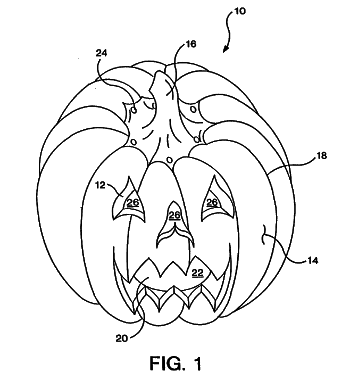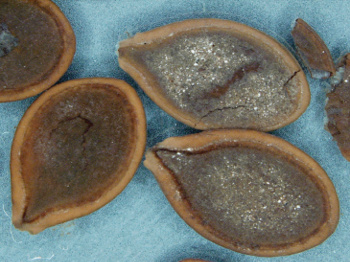Pumpkin Propagation
November 24, 2016
There are quite a few
food items associated with the
US Thanksgiving holiday, the most common being
turkey,
cranberry sauce, and
pumpkin pie. I've always been partial to the full-berried cranberry sauce, as opposed to the
jellied variety. I'm also old enough to remember the "
Great Cranberry Scare of '59."
About two weeks before the 1959 Thanksgiving holiday, it was revealed that some of that year's cranberry crop contained trace quantities of the
herbicide,
aminotriazole. In
laboratory testing, aminotriazole had been shown to cause
thyroid cancer in
rats. While 99% of the cranberry crop was not contaminated, there was no way for the
consumer to know whether a particular lot was
nontoxic. The product was not recalled; but, as could be expected, it was a generally cranberry-free Thanksgiving that year. My family tried
kumquats instead, but they weren't as
satisfying.
Pumpkin pie is so favored as to be a rival for
apple pie. Read, for example, the following song
lyrics from an 1806 book,
America's a dandy place:
The people are all brothers:
And when one's got a punkin pye,
He shares it with the others.[1]

Pumpkin harvesting extends from Halloween through Thanksgiving.
Fig. 1 of US Patent No. 5,811,160, "Carvable artificial pumpkin," by Jeffrey A. Chapman.
(via Google Patents.)
Presently, there are quite a few "
pumpkin-spiced" items, including
coffee (which, as a coffee
connoisseur, I will definitely
not try). The traditional
spice mix is mostly
cinnamon (55-65%) with about 12%
ginger, 12%
nutmeg, 6-9%
allspice, and 6-9%
cloves, although the cloves are sometimes omitted.
The word,
pumpkin, comes to us from the
Greek, πεπων, "large
melon." While the characterization of pumpkin as a melon seems strange, pumpkin is technically a
fruit, since it bears
seeds. Other
vegetables that are technically fruits are
tomatoes,
peppers,
cucumbers, and
avocado. They
propagate by
dispersal of their seeds, often by being
ingested by an
animal and
excreted elsewhere.

The general term, squash (examples shown), describes multiple species in the genus, Cucurbita. Pumpkin is of the Cucurbita pepo species of Cucurbita.
(Pennsylvania State University photo by George Perry).)
An interesting study by a diverse team of
scientists from
Pennsylvania State University, (University Park, Pennsylvania), the
University of Warwick (Coventry, United Kingdom), the
University of Cambridge (Cambridge, United Kingdom), the
Smithsonian Institution (Washington, DC), and the
Santa Fe Institute (Santa Fe, New Mexico) suggests that we wouldn't have our pumpkin pies if it weren't for the existence of large
herbivores, such as
mastodons, and their later demise.[3-4]
The wild pumpkin varieties of the distant past (more than 10,000 years ago) were
bitter and not
palatable to
humans and small
mammals.[3] Large herbivores, however, were willing to eat them, since these large animals had fewer bitter
taste receptors than smaller animals.[4] The possible reason for this is that larger animals can't be that particular about what they eat, since it takes a lot of food to maintain a large body mass. The bitter pumpkin seeds were dispersed in the
dung of these large-bodied herbivores.[3]

Fossilized Cucurbita seeds found in mastodon dung.
Fossil feces are called coprolite.
(Pennsylvania State University photo by Lee Newsom).)
Fruits of the Cucurbita were initially used by humans for purposes other than food, such as
containers and
floats for
fishing nets.[4] Eventually, some of these
cultivated Cucurbita
mutated to be less bitter; and, according to
Logan Kistler, an
author of the study from the University of Warwick, Cucurbita may have been
domesticated multiple times in different places.[3-4] Says Kistler,
"There is a huge amount of diversity in some of the domestic species and between them as well... Cucurbita pepo is probably the most variable, with jack-o-lantern pumpkins, acorn squash, zucchinis and others. Cucurbita moschata contains the butternut squashes and the kind of pumpkin that goes into the cans that a lot of folks will be baking into pies in a few weeks."[4]
The
ecological shift during the
Holocene and the
extinction of the
megafauna led to extinction of many wild Cucurbita species.[3] The cultivated varieties became the dominant varieties.[3] This
research was supported by the
Wenner-Gren Foundation, the
Natural Environment Research Council, and the Smithsonian Institution.[4]
References:
- Oliver Oldschool, The Portfolio, vol. II, (John Watts, Philadelphia, 1806), p. 123.
- Pumpkin, Wiktionary.
- Logan Kistler, Lee A. Newsom, Timothy M. Ryan, Andrew C. Clark, Bruce D. Smith, and George H. Perry, "Gourds and squashes (Cucurbita spp.) adapted to megafaunal extinction and ecological anachronism through domestication," Proc. Natl. Acad. Sci., vol. 112, no. 49 (December 8, 2015), pp. 15107-15112, doi: 10.1073/pnas.1516109112. A PDF file of the paper is available here.
- A'ndrea Elyse Messer, "Loss of mastodons aided domestication of pumpkins, squash," Pennsylvania State University Press Release,
November 20, 2015.
Permanent Link to this article
Linked Keywords: Food; US Thanksgiving holiday; turkey; cranberry sauce; pumpkin pie; fruit preserve; jellied; Great Cranberry Scare of '59; herbicide; 3-Amino-1,2,4-triazole; aminotriazole; laboratory; animal testing; thyroid cancer; laboratory rat; consumer; toxicity; nontoxic; kumquat; satisfy; apple pie; lyrics; United States; America; population; people; harvest; harvesting<; Halloween; Patent; Google Patents; pumpkin pie spice; pumpkin-spiced; coffee; connoisseur; spice; cinnamon; ginger; nutmeg; allspice; clove; pumpkin; Greek language; melon; fruit; seed; vegetable; tomato; pepper; cucumber; avocado; plant propagation; propagate; seed dispersal; ingestion; ingest; animal; excretion; excrete; squash; species; genus; Cucurbita; Cucurbita pepo; George Perry; scientist; Pennsylvania State University, (University Park, Pennsylvania); University of Warwick (Coventry, United Kingdom); University of Cambridge (Cambridge, United Kingdom); Smithsonian Institution (Washington, DC); Santa Fe Institute (Santa Fe, New Mexico); herbivore; mastodon; bitterness; bitter; palatability; palatable; human; mammal; taste receptor; feces; dung; fossil; Fossilize; coprolite; Lee Newsom; container; float; fishing net; horticulture; cultivate; mutation; mutate; Logan Kistler; author; domestication of plants; domesticate; jack-o-lantern; acorn squash; zucchini; Cucurbita moschata; butternut squash; baking; ecological shift; Holocene; extinction; megafauna; research; Wenner-Gren Foundation; Natural Environment Research Council.